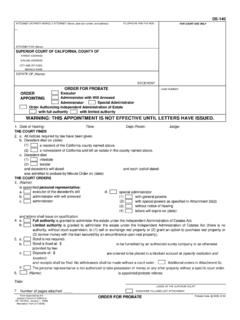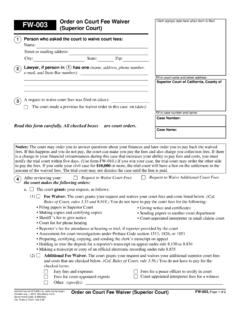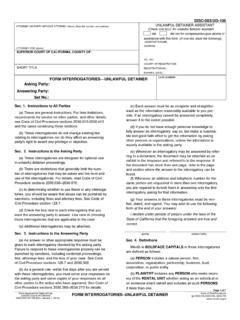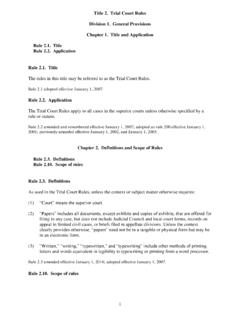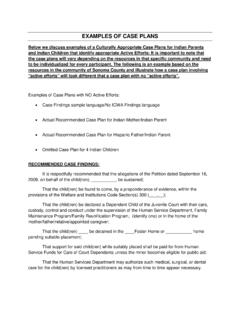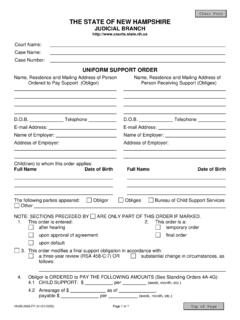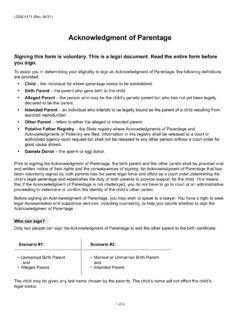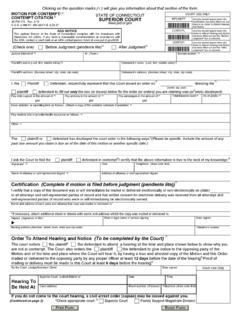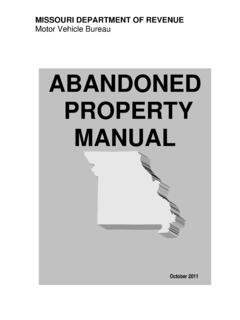Transcription of Emergency Protective Order Bench Guide - California
1 Revised March 16, 2020. California . JUDGES Guide TO. Emergency Protective ORDERS. This project was supported by Subgrant No. CW 19 18 1535 awarded by the state administering office for the STOP Formula Grant Program. The opinions, findings, conclusions, and recommendations expressed in this publication/program/exhibition are those of the author(s). and do not necessarily reflect the views of the state or Department of Justice, Office on Violence Against Women.. 1. Revised March 16, 2020. Emergency Protective Orders An Emergency Protective Order (EPO) is an Order requested by a law enforcement officer, typically when responding to a domestic violence or other Emergency situation.
2 An EPO is valid only if it is issued by a judicial officer. The law enforcement officer that makes the request is usually a sheriff or police officer but can be a peace officer from a school, parole officer, or probation officer. 1 An EPO is issued without prejudice. 2. Procedure The officer contacts the on-call judicial officer by phone to request the EPO. Typically, the officer completes an EPO form at the scene so parties can receive a copy. The Judicial Council has two mandatory forms for use: EPO-001 and EPO-002. Issuing the EPO on the wrong Judicial Council form (out-of-date) or no form, in and of itself, does not make the EPO unenforceable.
3 3 An EPO may be requested 24 hours a day, 7 days a week. 4 The procedures for contacting the on-call judge, commissioner, or referee vary from court to court. Situations Warranting an EPO. A judge may issue an EPO, when an officer asserts reasonable grounds to believe that: 1. There is an immediate harm or present danger (see chart on pages 2-3 for situations in which an EPO may be issued); and 2. An EPO is necessary to prevent the occurrence or recurrence of abuse, abduction, or injury. 5. The fact that the protected person left the home to avoid abuse has no bearing on the availability of an EPO.
4 6. Tips Whether the protected person left the home to avoid abuse has no impact on the availability of an EPO;1 and Whether the respondent is in custody has no bearing on this factor. You do not know when the respondent will be released. 1. Fam C 6240(b). 2. Fam C 6255. 3. Fam C 6221(c). 4. Fam C 6241. 5. Fam C 6251(b). 6. Fam C 6254. 2. An EPO may be issued when there are reasonable grounds to believe any of the following: Revised March 16, 2020. Domestic violence Court must find that there is: 1. An immediate and present danger of domestic violence 7 based on an allegation of recent abuse or threat of abuse; and 2.
5 A qualifying relationship between the protected person and restrained person. Abuse is any of the following: 1. to intentionally or recklessly cause or attempt to cause bodily injury;. 2. sexual assault;. 3. to place a person in reasonable apprehension of imminent serious bodily injury to that person or to another; and 4. to molest, attack, strike, stalk, threaten, batter, harass, telephone, including, but not limited to, making annoying telephone calls as described in Section 653m of the Penal Code, destroy personal property, contact, either directly or indirectly, by mail or otherwise.
6 Come within a specified distance of, disturb the peace, credibly impersonate 8, or falsely personate 9. Qualifying relationship means that the protected person and restrained person: 1. have/had an intimate relationship ( married, dated, or had a child together);. 2. cohabitate/cohabitated together (lived together as a family or social unit not just as roommates); or 3. are related by blood or marriage within the second degree ( restrained person must be the parent, child, grandparent, or sibling of protected person). Child abuse Child is in immediate and present danger of abuse by a family or household member based on an allegation of recent abuse or threat of abuse.
7 10 See above for definition of abuse. Child abduction Child is in immediate and present danger of abduction by a parent or relative based on a reasonable belief that a person has an intent to abduct the child or flee with the child or based on an allegation of a recent threat to abduct or flee with the child. 11. 7. Domestic violence is defined as abuse perpetrated by someone who has a qualifying relationship with the protected person. Fam. C 6211. 8. Pen. C 9. Pen. C 529. 10. Fam C 6250(b). 3. Revised March 16, 2020. Elder or Immediate and present danger of abuse based on an allegation of recent dependent adult abuse or threat of abuse as defined under Welfare and Inst.
8 Code section abuse May not be issued solely on allegations of financial abuse. 12. Stalking Immediate and present danger of stalking based on the person's (no specific allegation that they have been willfully, maliciously, and repeatedly relationship followed or harassed by another person. It must be a credible threat required) made with the intent to place the person who is the target of the threat in reasonable fear for their safety or the safety of their immediate family. 13. Unlike domestic violence, stalking does not require that the parties have a qualifying relationship.
9 Gun violence A person who poses an immediate and present danger of causing personal injury to themselves or another by having in their custody or control, owning, purchasing, possessing, or receiving a firearm may be enjoined through an Emergency Gun Violence Restraining Order (form This EPO only EPO-002). restricts access to guns and Authority for this EPO is contained in Penal Code section 18125 et seq. ammunition. and not within the Domestic Violence Prevention Act. Tips Respond promptly to the requesting peace officer to allow the officer to get back on patrol.
10 Provide clear orders to the officer so that the EPO form is filled out properly. Ask the officer to note on the EPO form if firearms were observed, reported, searched for, or seized. Stay away orders should include locations such as school, work, and daycare, if necessary. DV Task Force Recommendation: Before issuing an EPO, the on-call judge should ask the law enforcement officer who is requesting the Order if the officer has asked the victim, proposed restrained person, or both, whether a firearm is present at the location. Pen C. 13730. Final Report, page 23, #7.
